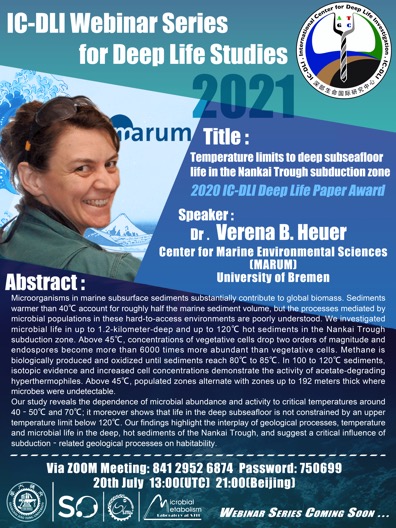搜索


【IC-DIL Webinar】
Speaker:Dr. Verena B. Heuer
Title:“Temperature limits to deep subseafloor life in the Nankai Trough subduction zone”
Time:20th July 2021, 13 : 00 pm [UTC] 21: 00 pm [Beijing]
ZOOM Meeting:841 2952 6874; Passcode:750699;
Join Zoom Meeting:https://us06web.zoom.us/j/84129526874?pwd=SEJQbzA3bjhHZDVWbXc3d0ZBYXlYdz09
Abstract:
"Microorganisms in marine subsurface sediments substantially contribute to global biomass. Sediments warmer than 40°C account for roughly half the marine sediment volume, but the processes mediated by microbial populations in these hard-to-access environments are poorly understood. We investigated microbial life in up to 1.2-kilometer-deep and up to 120°C hot sediments in the Nankai Trough subduction zone. Above 45°C, concentrations of vegetative cells drop two orders of magnitude and endospores become more than 6000 times more abundant than vegetative cells. Methane is biologically produced and oxidized until sediments reach 80° to 85°C. In 100° to 120°C sediments, isotopic evidence and increased cell concentrations demonstrate the activity of acetate-degrading hyperthermophiles. Above 45°C, populated zones alternate with zones up to 192 meters thick where microbes were undetectable."
"Our study reveals the dependence of microbial abundance and activity to critical temperatures around 40‐50°C and 70°C; it moreover shows that life in the deep subseafloor is not constrained by an upper temperature limit below 120°C. Our findings highlight the interplay of geological processes, temperature and microbial life in the deep, hot sediments of the Nankai Trough, and suggest a critical influence of subduction‐related geological processes on habitability."




 首页
首页

 学院概况
学院概况

 师资队伍
师资队伍

 人才培养
人才培养

 招生就业
招生就业

 科学研究
科学研究

 平台基地
平台基地

 党群工作
党群工作

 校友之家
校友之家

 安全工作
安全工作

 网上办事
网上办事

 当前位置:
当前位置: